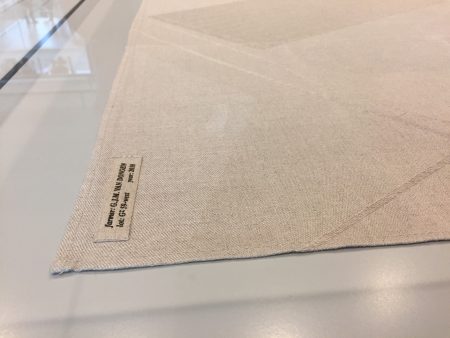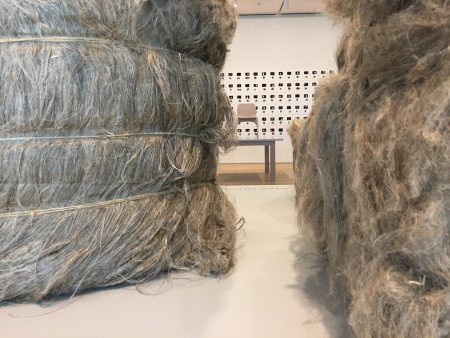“Everything Connects,” exhibiting at the Art Institute of Chicago through October 20, showcases the process and discoveries of Dutch designer Christien Meindertsma. Meindertsma’s practice bridges the gap between sleek designer and obsessive fiber researcher, examining the stories of products and their raw materials.
The exhibition, displayed in the Department of Architecture and Design, highlights Meindertsma’s long-term exploits, the “Flax Project” and “Fibre Market,” in which she explores both the creation and destruction of our consumer fiber products.
The “Flax Project” began in 2012 when Meindertsma began following the growth and manufacture of flax—the plant used to make linen—by Gert Jan van Dongen, a farmer in the the Netherlands. In a plaque written by Meindertsma, she writes that she is “intrigued by the linen clothing depicted in paintings from the 17th century and the linen damask tablecloths depicted in still-life paintings, as well as the linen canvases that the artists painted on. These textiles were treasured possessions, cherished in a way that fabrics are rarely appreciated today.”
After months of watching the flax crop grow and videographer Roel van Tour documenting the process, Meindertsma decided to buy the whole crop. That ended up clocking in at 22,046 pounds of fiber she was able to produce from the 15-acre harvest.
“I wanted to find out what its possibilities were,” she writes. “And it seemed to me that it was just enough material to research and industrially produce a collection of products.”
From here, Meindertsma began to investigate if locally-produced flax could ever become a viable commodity once again. During this process, she created an entirely biodegradable chair, which went on to win the Dutch Design Award in 2016. The chair is proudly displayed in the exhibit space, along with a number of other fascinating artifacts from the “Flax Project,” exploring the material at all stages of production—from the actual bundles of flax, to the industrially-produced sheets of linen, tagged with the name of the farmer and the year of the harvest. The exhibit does an incredible job of charting the full scope of the process.

An industrially-made sheet of flax fiber, tagged with the name of the farmer and year of the harvest.
“Fibre Market” is another process-intensive study of fabrics—only in this project the artist deconstructs common consumer clothing using state-of-the-art fiber-sorting machines. This study ultimately yields interesting re-uses for these materials, and it uncovers some lies being sold to us by our clothing brands.
The fiber sorting machines used for “Fibre Market” were recently developed by Wieland Textiles and Valvan Bailing Systems. These machines can scan and sort clothing according to their wool, nylon, and acrylic material contents. Meindertsma used these machines to sort 1,000 sweaters, which revealed a number of discrepancies from what the manufacturer had put on the label. This process is displayed in a wall full of fiber samples with their respective material content readings—many of which have tags reading “100% Wool,” but get readings of only around 60% wool from the machines.

Samples from sweaters sorted by fiber sorting machines, their material results, and their shredded fibers.
“These discoveries are important not only because consumers—as well as producers along the value chain—may not be buying what they think they are,” Miendertsma writes. “But also because recycling fibers on an industrial scale requires precise knowledge of their content.”
The sorted sweaters were eventually shredded into fiber which Meindertsma made into a recycled version of Irish Donegal Tweed fabric—a fabric developed centuries ago in a response to a scarcity of colorful yarn, peppering color sparsely throughout to create a decorative effect. This recycled fabric is displayed throughout the exhibition space tables.

A bundle of recycled fabrics sits in front of the wall of sweater remains, sorted by fabric sorting machines.
Whether it be from an environmental angle, an animal rights angle, or an economic angle, fiber production has been a hot-button humanitarian issue for ages. Meindertsma seeks to change the fiber production and recycling game by digging her heels into this research to find creative and ethical innovations to the field.
“Everything Connects” stands out for its meticulous curation of Meindertsma’s full research process, as opposed to just her end results. There is much to be learned for anyone from the average viewer to the fabric connoisseur through observing this timeline of creative production.
–Russell Hausfeld





